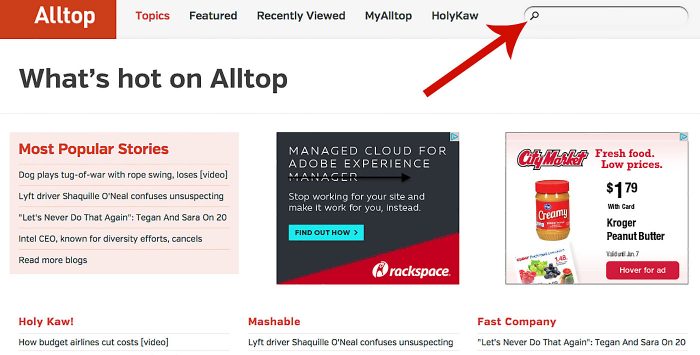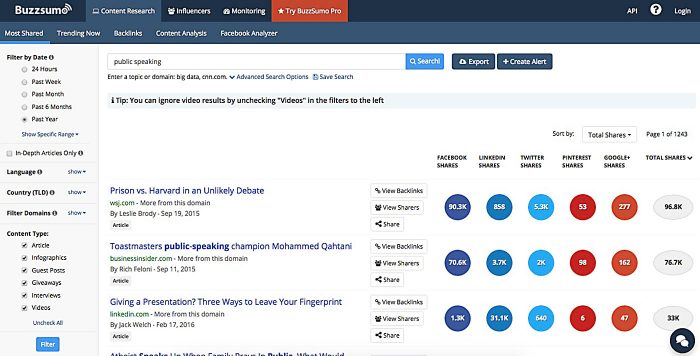Every few months, a hot, new social media tool hits the scene — Pinterest, Periscope, Foursquare, Blab — and some marketing experts make it sound like if you’re not using that new platform, you’re missing out.
That notion gives me a massive headache. Like everyone else, I feel pressured to have a presence on every social media platform, but I can’t possibly contribute to every one — at least not without doing a lousy job on all of them.
Wouldn’t it be great if we could simply focus our social media marketing efforts on one or two platforms we know our prospects use to share content and connect with one another?
But how do you know which social media sites to choose?
Smart social media marketing research
If you take a wild guess at your audience’s favorite social media platforms, you may guess incorrectly, resulting in wasted time and missed opportunities.
To avoid mistakes, conduct smart research, figure out which social media sites your audience prefers, and then spend the majority of your social media marketing efforts on those sites.
But that process isn’t as straightforward as you might think. I asked the smartest people I know in the marketing world where they would go to find this information, and I got a lot of different answers. It turns out, there’s no “magic website” you can use to do this research.
Let’s go through this slightly messy process, step by step, so you feel comfortable doing it for your own audience.
Step #1: Conduct interviews with your ideal clients
The best way to find out where your target audience hangs out online is (surprise!) to ask them. The first thing you should do is arrange informal interviews with your favorite clients or customers.
To do this, simply write a short list of questions and reach out to five to ten people from your existing social media following or email list. It’s best to target people you think of as your favorite or ideal clients and customers — active members of your community who you trust to give honest feedback.
Once you’ve got your list, email or call each person and ask if you can chat with them on the phone for 20 minutes and ask them some questions.
During your interviews, ask them about their favorite social platforms, where they typically share content online, and where they typically connect with their friends, family, colleagues, and community members.
Take notes on your conversations — or better yet, record the interviews (with permission, of course).
Step #2: Set up a survey, and use it to gather data from your audience members
Your most reliable information will likely come from client and customer interviews, but unfortunately, interviews don’t scale well.
To collect more data, set up a brief, to-the-point survey and distribute it to your audience. If you first conduct a handful of interviews, you can use the information you gather to craft the survey questions.
Your primary question should be: “Which social networking site (Facebook, Pinterest, Twitter, LinkedIn, Google+, YouTube, Instagram, etc.) do you use the most?”
You can also include other relevant questions that will help you understand their social media behaviors.
Step #3: Find websites similar to yours
Next up, we’re going to do a little competitive research.
Your job in this step is to brainstorm and put together a list of about five to ten websites that serve the audience you’re trying to reach.
Create an Excel spreadsheet or Google doc to track this information, so you can keep everything organized and in one place.
Think of competitors’ sites or referral partners, and then perform a quick online search to find additional sites. For example, enter “[YOUR TOPIC] + blog” or “[YOUR TOPIC] + podcast” into Google and hit enter. Review the search results to see if your target audience would spend time on those sites.
You can also search on AllTop to find similar sites.

BuzzSumo can be used for competitive research, as well. Enter any topic in the front page search bar, click the “Search!” button, and you’ll see a list of the most-shared posts on that topic, from a variety of websites.

As you discover new sites, add them to your spreadsheet.
Step #4: Find out which social platforms the visitors of those sites use to share content
Our next step is to research the social sharing habits of the people who visit the sites on our list. The question you’re trying to answer here is: “When a typical visitor to [WEBSITE NAME] shares a piece of content from this site, which social networking platforms do they use to share it?”
You can go back to BuzzSumo and perform a slightly different type of search to find this information. On the BuzzSumo home page, look for a blank search field. This time, enter the domain name of the first site on your research list, and click the “Search!” button.
For instance, a results page for PublicWords.com looks like this:

BuzzSumo gives us the top five most-popular posts for that website (from the past year) and then displays social data for that post from Facebook, LinkedIn, Twitter, Pinterest, and Google+.
Once you’ve noted the most popular sharing platform for this site, repeat the process for all five to ten blogs on your list. Trends should emerge, and you’ll likely be able to discover readers’ top two favorite social sites.
If you’re looking for even more data, you can also try website analytics platforms. Check out this Semrush vs. Similarweb review to find out more about what each has to offer.
Step #5: Research your target social platform, and make sure it’s a match for your customers’ preferences and worldviews
At this point, hopefully you’ve narrowed down your potential options to one or two social media sites.
Now it’s time to make sure they’re a good match for your business, marketing goals, and customers’ worldviews. This part of your research is more subjective — it’s essentially a “gut check” test.
During this step, look at:
- The typical demographics of the social site. Many social sites publish demographic information about their users, so you can see a breakdown of the ages and genders of the users.
- The features of the social networking platform. For instance, Instagram and Pinterest are highly visual, so any company that decides to market using these two tools should be prepared to create appealing visual content.
- Your marketing goals. Will this platform help you accomplish your content marketing goals?
Here are some examples of how this might work for content marketers:
- A food blogger decides to focus her social media efforts on Pinterest, because she’s targeting moms who make healthy lunches for their kids. Food is a popular topic on Pinterest, so she can be reasonably certain Pinterest would be a good platform for her to use to reach her target audience.
- A B2B company that sells software as a service (SaaS) has performed research and knows their target audience shares content and connects with colleagues and prospects on LinkedIn, so they decide to try out the platform and see how it performs for them.
- A tattoo artist creates a presence on Instagram because the primarily image-based platform is an ideal place to showcase his portfolio.
The statements above are generalizations, and — as always — your mileage may vary. The most important thing is that you know who you’re trying to reach and perform your own research on the best ways to connect with them.
Spend your social media marketing time and money wisely
When you decide to build a presence on a social networking site, run tests to make sure you’re on the right track.
For example, if you want to give Pinterest a shot, because your research is telling you that’s where your audience hangs out, then throw yourself wholeheartedly into developing a Pinterest following. Give it six to eight months, then review your data to see if you’re getting the results you want (in terms of traffic, subscribers, and conversions).
If a platform isn’t working out for you, don’t be afraid to move it lower on your marketing priority list or drop it completely — no matter what your pre-research says.
You may want to repeat the steps above every six to twelve months, to stay on top of changing trends and remain in touch with your target audience’s behaviors from year to year.
Over to you …
The best way to make social media work for you as a content marketer is to find out where your perfect prospects are and spend time there. Don’t go to the places where they’re not hanging out.
When you conduct your research thoughtfully and make your decisions based on that research, you’ll get far better results.
How do you decide which social media sites to spend time on? Share in the comments below.

Reader Comments (24)
Hi, Beth.
Great article on social media research. I’ve bookmarked it to refer back to again and again.
I have a question. I’m a B2B copywriter, so I “hang out” a lot on LinkedIn. I may have missed this, but do you check out prospects’ profiles and websites to see what social media networks they promote? You know, the old “find us on X” and the share buttons on their site.
Would that information be useful when doing research? That, of course, in addition to the research sites you mentioned.
Thanks!
Steve
Hi, Steve!
Yes, that would be a great idea! Thanks for the suggestion!
It’s definitely a good way to have a look and see which networks people prioritise, the only downfall is you don’t know if the your actual ideal customer spends time on that site. For example, if you’re looking to connect with the CEO of a medical manufacturing company, they may have a Twitter account for the brand because they think ‘everyone has a Twitter account’, but the CEO doesn’t necessarily use it himself
Great post. Some very interesting opportunities are presented. I agree 100% that trying to excel at all social platforms is impossible.
Wally
Beth,
Great article! I have noticed that different niches I’m involved in prefer different social media outlets. For example, the photography niche prefers Instagram, while video production is primarily on YouTube or Vimeo. Thanks for writing this article it really got my brain moving this morning.
You’re welcome, Seth!
This was very helpful. I have experienced that feeling of being overwhelmed by social media possibilities and the self-proclaimed business gurus advising that we need to be on all of them. Who has time for that!? Thanks for this sensible, step-by-step approach.
Michele – I don’t have know how the folks who are active on *all* the social networking sites actually get anything done. As business owners and marketers, if we’re not in the position to pay someone to post and engage on our behalf, it’s just not feasible or practical!
Great post. Really helpful. It also depends on your content marketing goals if you your primary purpose is branding then FB works but if you want to get more leads and clients then nothing ca beat Twitter & LinkedIn. Both are the best for your business but to make it happen you have devote your time on it. At-least 30 minutes to one hour a day.
I also heard about Instagram which is going to be more popular day by day.
Hi, Gaurav –
I don’t think we can make the blanket statement that Twitter and LinkedIn are ALWAYS best for lead generation….it totally depends on where your audience is. I have a friend who is killing it on Pinterest right now, and has more graphic design clients than she can handle because of what she’s doing on that platform. So you just never know – that’s why it’s always best to research it thoroughly.
More tips all the way. This is definitely a way forward for me.
Thanks Beth.
I’ve used surveys for my own email list to try to guage what type of products they want to buy. It’s pretty effective.
Totally, Edwin! And I like that I can take quotes from my surveys and use them in my marketing materials, too!
Very interesting strategies. I prefer going to a direct approach and do a survey. That has been the easiest and fastest way to get this kind of information.
I had never thought of Buzzsumo as a social intelligence tool until right now. Duh ! Makes a whole lot of sense. And I totally agree when you say it is better to focus on the handful of platforms that DO work for you and your business unless of course you have a large team and each and every platform is working for you.
Thanks Beth.
Great post, specialy this part: “A tattoo artist creates a presence on Instagram because the primarily image-based platform is an ideal place to showcase his portfolio.”… If you ask me, will like to see the artist use other medias!
They’re definitely great to learn from but atm Facebook everybody or businesses would definitely be on it.
That was surely a great post Beth. Thanks for sharing.
I have one question as a content marketer i mainly depend on natural SEO and some what i make use Facebook. Can You suggest me some other platform which can give me some good reach?
Thanks in advance. 🙂
Hi Tusher – that totally depends on the audience you’re trying to reach. I think the process I’ve talked about in this article is a good next step for you. Good luck!
Great article. Thanks!
When you’re in the early stages of building your online community, as we are, promotional and marketing activities often are far too spontaneous and reactive. Thanks for the reminder of how important it is to create and stick with a tribe building strategy, and to get customer feedback… Now onto its implementation!
I honestly had no idea about Buzzsumo. Thank you for sharing Beth!
Wow this post great, thanks for sharing Beth. I’ll try Buzzsumo
For my clients facebook and twitter are best tools.
As you mentain that we should contact interview and survay for better response.
Thanks
This article's comments are closed.